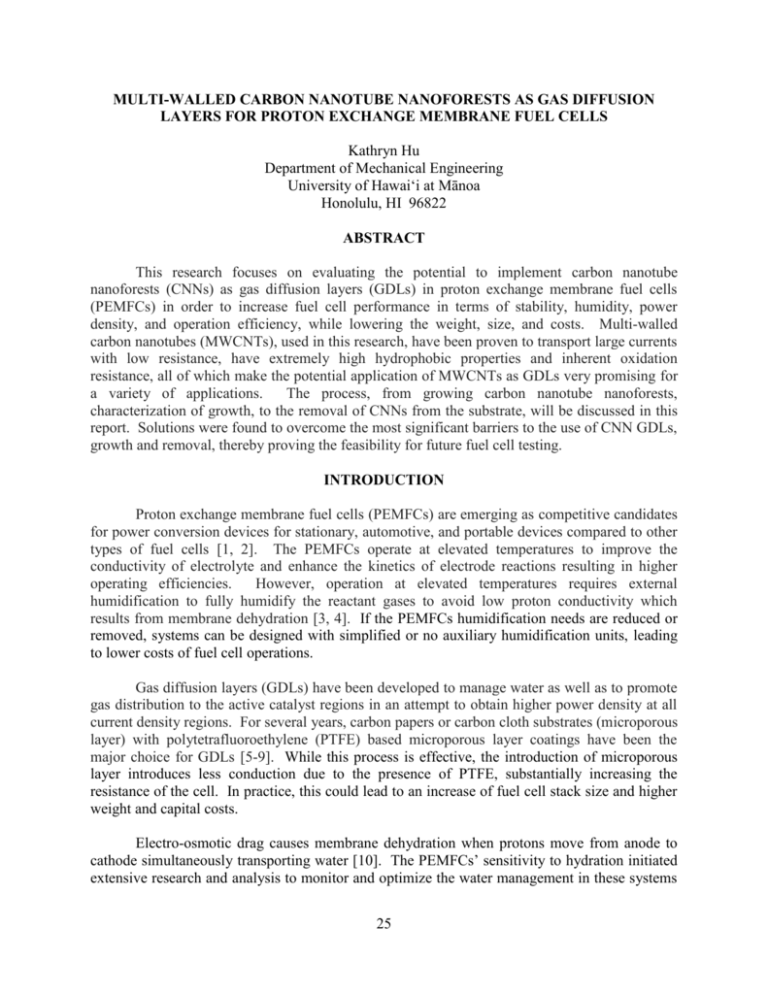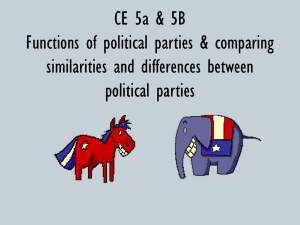REVISED_HuK_SP15
advertisement

MULTI-WALLED CARBON NANOTUBE NANOFORESTS AS GAS DIFFUSION LAYERS FOR PROTON EXCHANGE MEMBRANE FUEL CELLS Kathryn Hu Department of Mechanical Engineering University of Hawai‘i at Mānoa Honolulu, HI 96822 ABSTRACT This research focuses on evaluating the potential to implement carbon nanotube nanoforests (CNNs) as gas diffusion layers (GDLs) in proton exchange membrane fuel cells (PEMFCs) in order to increase fuel cell performance in terms of stability, humidity, power density, and operation efficiency, while lowering the weight, size, and costs. Multi-walled carbon nanotubes (MWCNTs), used in this research, have been proven to transport large currents with low resistance, have extremely high hydrophobic properties and inherent oxidation resistance, all of which make the potential application of MWCNTs as GDLs very promising for a variety of applications. The process, from growing carbon nanotube nanoforests, characterization of growth, to the removal of CNNs from the substrate, will be discussed in this report. Solutions were found to overcome the most significant barriers to the use of CNN GDLs, growth and removal, thereby proving the feasibility for future fuel cell testing. INTRODUCTION Proton exchange membrane fuel cells (PEMFCs) are emerging as competitive candidates for power conversion devices for stationary, automotive, and portable devices compared to other types of fuel cells [1, 2]. The PEMFCs operate at elevated temperatures to improve the conductivity of electrolyte and enhance the kinetics of electrode reactions resulting in higher operating efficiencies. However, operation at elevated temperatures requires external humidification to fully humidify the reactant gases to avoid low proton conductivity which results from membrane dehydration [3, 4]. If the PEMFCs humidification needs are reduced or removed, systems can be designed with simplified or no auxiliary humidification units, leading to lower costs of fuel cell operations. Gas diffusion layers (GDLs) have been developed to manage water as well as to promote gas distribution to the active catalyst regions in an attempt to obtain higher power density at all current density regions. For several years, carbon papers or carbon cloth substrates (microporous layer) with polytetrafluoroethylene (PTFE) based microporous layer coatings have been the major choice for GDLs [5-9]. While this process is effective, the introduction of microporous layer introduces less conduction due to the presence of PTFE, substantially increasing the resistance of the cell. In practice, this could lead to an increase of fuel cell stack size and higher weight and capital costs. Electro-osmotic drag causes membrane dehydration when protons move from anode to cathode simultaneously transporting water [10]. The PEMFCs’ sensitivity to hydration initiated extensive research and analysis to monitor and optimize the water management in these systems 25 [11-14]. The results of these studies identify operating conditions that result in water balance for the proposed PEMFC model by controlling factors such as operating temperature, pressure, reactant gas temperatures, and the humidity of reactant gases. In addition to modeling, different types of PEMFC humidification systems have also been studied, the more common including direct injection [15] which adds water directly to the gas inlets, and external membrane humidifiers [16] which flow gas over a water permeable membrane causing the gas to absorb water. Due to MWCNTs ability to transport large currents with low resistance and their extremely high hydrophobic properties and corrosion resistance, implementing MWCNTs as GDLs has the potential to significantly decrease or eliminate the need for complicated humidification systems. EXPERIMENTAL METHODS Carbon Nanotube Nanoforest (CNN) Growth CNN growth in this research is achieved by a chemical vapor deposition (CVD) process which involves the decomposition of a carbon-containing gas. Gas-phase processes are known to produce nanotubes with fewer impurities and can be more easily implemented for large-scale processing. To grow the MWCNTs, the six-inch diameter CVD furnace was first purged with argon gas while heating to operating temperature. A precursor mixture of ferrocene and xylene was vaporized and injected into the furnace whose temperature was held steady at 750° C. The ferrocene then deposited itself onto the surface of silicon dioxide wafers upon which the MWCNTs grew following a base-growth model, depicted in Figure 1. Figure 1. (a) Tip-growth and (b) Base-growth models for MWCNT CVD growth [17]. The growth was kept in the inert, argon environment until the entire volume precursor had been injected into the furnace and the furnace was cooled to below 200° C. Obtaining consistent, good quality growth required a considerable amount of effort to ensure the stable operation of the furnace and to determine the best gas and precursor flow parameters. 26 CNN Characterization Using Electron Microscopy Characterization was achieved via Scanning and Transmission Electron Microscopy, SEM and TEM, respectively. These visualization methods verified the quality and characteristics of the CNN growths to be used for GDLs. SEM provided a means to directly observe the MWCNT’s size, shape, and structure. TEM was allowed for the measurement of MWCNT inner and outer diameters, and thus the approximate number of walls. [18]. CNN Removal from Substrate In order to be used as a GDL, the CNN growth needed to be isolated from the silicon dioxide wafer substrate and catalyst layer. However, given that the CNN is only held together with van der Waals forces, the growth was extremely fragile and difficult to handle. Scraping the growth from the substrate caused the layer to crumble or break, as can be seen in Figure 2. Figure 2. Broken pieces of CNN resulting from attempting to scrape the CNN off the substrate. In previous studies, the CNN was first removed from the substrate by dissolving the oxide layer using Sigma Aldrich Ceramic Etchant A or Alumiprep 33 [19]. Both aforementioned chemicals are hydrofluoric acid replacements, intended to reduce the safety risks of using hydrofluoric acid. Multiple rinses alternating between hydrochloric acid and deionized water were then used to remove the ferrocene catalyst layer from the CNN, leaving only the pure nanoforest. Despite the process having been tested and proven, supported by the Patent #WO 2011106109 A2 “Nanotape and nanocarpet materials,” the removal process was not so simple for the GDL-required thickness of the CNN growth. Obtaining a full, 3”x3” sheet of CNN was extremely difficult due to the fragility of the material and its susceptibility to breaking while handling. RESULTS AND DISCUSSIONS Carbon Nanotube Nanoforest (CNN) Growth It was confirmed that there is a direct correlation between the amount of ferrocene-xylene precursor injected and the amount of growth on the substrate. This was an expected result given that the ferrocene and xylene mixture contains the building blocks for the MWCNT. Several tests also yielded the ideal hydrogen to argon gas flow rate ratio to be 20% since hydrogen 27 carries the precursor through the furnace. Through a variety of trial and error processes, a set of parameters yielding consistent, uniform, high quality CNN growth was achieved. Figure 3 and 4 below represent some of the different growth results obtained throughout testing. (a) (b) Figure 3. (a) SiO2 wafer prior to CNN growth and (b) Ideal, uniform, good quality CNN growth. Figure 4. Examples of other growths on SiO2 resulting from different parameters. CNN Characterization Using Electron Microscopy Using microscopes from the Pacific Biosciences Research Center (PBRC) Biological Electron Microscope Facility, information about the good quality growths was obtained from both the SEM and TEM and can be seen below. 28 Figure 5. SEM side-view at 900 times magnification of CNN growth with height measurement. Figure 5, an image obtained from the SEM of a good quality CNN growth, verified the intended verticality of the overall nanoforest. This also confirmed that the growth was the appropriate height needed to be used as a GDL membrane (50 – 90 𝜇m). Figure 6 below is a further magnified view of the side of the growth in Figure 5. This shows the more interwoven or tangled arrangement of the actual CNN; however, the overall verticality shown in Figure 5 is the important aspect desired for the GDL. Figure 6. SEM side-view at 30,000 times magnification of CNN growth. Images taken from the TEM verified the quality of MWCNT growth by allowing the visualization of distinct inner and outer walls of the CNT, as can be seen in Figure 7 below. 29 Figure 7. TEM image of single MWCNT sampled from the CNN. From Figure 7, the total MWCNT thicknesses could be measured and were on average about 10 nm. The darker spot on the image is the ferrocene catalyst within the MWCNT. In comparison to other CNN growth brought to the PBRC for analysis by other departments, the growth obtained for this research is significantly greater in quality due to the obvious cylinder and wall definition. CNN Removal from Substrate Comparatively testing Alumiprep 33 versus the Ceramic Etchant A showed that Alumiprep is more effective for removing the CNN from the substrate than the Ceramic Etchant. It was found that the time needed for the CNN layer to separate from the SiO 2 wafer was inversely proportional to the thickness of the growth, requiring 16 to 27 minutes to fully separate rather than the predicted 90 seconds. Separation initiated from any exposed SiO2 surfaces; therefore if the growth was not uniform in thickness, spots of thinner growth would lead to ruptures through the growth as can be seen in Figure 8. Further testing brought upon the issue of handling separated CNN pieces, as they would quickly rip if not fully supported. Upon rinsing with deionized water and setting aside to dry, the pieces of growth obtained from the removal step cracked or broke into even smaller pieces when dry and were then stuck to the petri dish. 30 Figure 8. CNN separating from the SiO2 wafer after being submerged in Alumiprep 33. In order to control the separation process and yield full sheets of CNN, the edges of the SiO2 wafer were scraped and approximately 1/8” of wafer was exposed around the perimeter. A 4”x4” square of 5% teflonized carbon paper was placed under the wafer to more easily lift the separated CNN layer after separation. Alumiprep was poured around the edges of the wafer first to facilitate the edges’ removal then the entire wafer was covered to a depth of approximately 0.5 inches. Once the CNN fully separated from the SiO2 wafer, the wafer was carefully slid out from between the CNN layer and the carbon paper. With the CNN centered on the carbon paper, the CNN could be fully supported as it was slowly raised out of the Alumiprep. Keeping all CNN surface flat on the carbon paper, the growth was rinsed in several consecutive deionized water baths. The result of this process is pictured in Figure 9. Figure 9. Complete CNN growth removed from SiO2 substrate with Alumiprep 33 and dried on 5% teflonized carbon paper. CONCLUSIONS & FUTURE WORK The successful demonstration of growth of high quality CNN of the appropriate GDL thickness and the ability to separate large pieces of CNN from the substrate suggests that it is feasible to implement a MWCNT CNN as a GDL. Given that the growth, removal, and handling of the CNN are primary roadblocks limiting the possible use for these GDLs in large-scale applications, the solutions presented in this research give way to promising improvements for fuel cell technologies. Based on prior research, it is expected that this CNN GDL will 31 substantially improve the performance of a large-scale PEMFC. Additional research will be conducted to test our optimized CNN as GDLs in a large-scale industrial PEMFC apparatus. ACKNOWLEDGEMENTS My deepest gratitude to Dr. Nejhad for allowing me to conduct this research and giving me the opportunity to explore an area of research closely aligned with my career interests. Thank you to Brenden Minei, Kyle Wong, Caton Gabrick, Adrian DeLeon, Sterling Gascon, and Vamshi Gudapati for their help and insights during this research. Also, many thanks to Tina Carvalho at the Pacific Biosciences Research Center for training and allowing me to use the TEM and SEM. REFERENCES [1] Whittingham, M. Stanley, Thomas Zawodzinski, and Robert F. Savinell. "Introduction: Batteries and Fuel Cells." Chem. Rev. Chemical Reviews 104.10 (2004): 4243-244. Print. [2] Service, R. F. "FUEL CELLS: Shrinking Fuel Cells Promise Power in Your Pocket." Science 296.5571 (2002): 1222-224. [3] Zawodzinski, Thomas A., et al. "Water Uptake by and Transport Through Nafion® 117 Membranes." J. Electrochem. Soc. Journal of The Electrochemical Society 140.4 (1993): 1041. Print. [4] Büchi, Felix N., and Supramaniam Srinivasan. "Operating Proton Exchange Membrane Fuel Cells Without External Humidification of the Reactant Gases." J. Electrochem. Soc. Journal of The Electrochemical Society 144.8 (1997): 2767. [5] Dicks, Andrew L. "The Role of Carbon in Fuel Cells." Journal of Power Sources 156.2 (2006): 128. [6] Kannan, Arunachala M., Vinod P. Veedu, Lakshmi Munukutla, and Mehrdad N. GhasemiNejhad. "Nanostructured Gas Diffusion and Catalyst Layers for Proton Exchange Membrane Fuel Cells." Electrochemical and Solid-State Letters Electrochem. Solid-State Lett. 10.3 (2007): B47. [7] Kannan, A.M., L. Cindrella, and L. Munukutla. "Functionally Graded Nano-porous Gas Diffusion Layer for Proton Exchange Membrane Fuel Cells under Low Relative Humidity Conditions." Electrochimica Acta 53.5 (2008): 2416-422. [8] Chen-Yang, Y.W., T.F. Hung, J. Huang, and F.L. Yang. "Novel Single-layer Gas Diffusion Layer Based on PTFE/carbon Black Composite for Proton Exchange Membrane Fuel Cell." Journal of Power Sources 173.1 (2007): 183-88. [9] Park, Gu-Gon, et al. "Adoption of Nano-Materials for the Micro-Layer in Gas Diffusion Layers of PEMFCs." Journal of Power Sources 163.1 (2006): 113-18. 32 [10] Zawodzinski, Thomas A. "A Comparative Study of Water Uptake By and Transport Through Ionomeric Fuel Cell Membranes." J. Electrochem. Soc. Journal of the Electrochemical Society 140.7 (1993): 1981. [11] Bernardi, Dawn M. "Water-Balance Calculations for Solid-Polymer-Electrolyte Fuel Cells." J. Electrochem. Soc. Journal of the Electrochemical Society 137.11 (1990): 3344. [12] Sridhar, P., Ramkumar Perumal, N. Rajalakshmi, M. Raja, and K.S Dhathathreyan. "Humidification Studies on Polymer Electrolyte Membrane Fuel Cell." Journal of Power Sources 101.1 (2001): 72-78. [13] Ren, Xiaoming, and Shimshon Gottesfeld. "Electro-osmotic Drag of Water in Poly(perfluorosulfonic Acid) Membranes." J. Electrochem. Soc. Journal of the Electrochemical Society 148.1 (2001): A87. [14] Chiang, M-S, and H-S Chu. "Effects of Temperature and Humidification Levels on the Performance of a Proton Exchange Membrane Fuel Cell." Proceedings of the Institution of Mechanical Engineers, Part A: Journal of Power and Energy 220.5 (2006): 435-48. [15] Wood, David L., Jung S. Yi, and Trung V. Nguyen. "Effect of Direct Liquid Water Injection and Interdigitated Flow Field on the Performance of Proton Exchange Membrane Fuel Cells." Electrochimica Acta 43.24 (1998): 3795-809. [16] Chen, D., Li, W., and Peng, H. An Experimental Study and Model Validation of a Membrane Humidifier for PEM fuel Cell Humidification Control. [17] Mukul Kumar (2011). Carbon Nanotube Synthesis and Growth Mechanism, Carbon Nanotubes - Synthesis, Characterization, Applications, Dr. Siva Yellampalli (Ed.), ISBN: 978-953-307-497-9, InTech, DOI: 10.5772/19331. Available from: http://www.intechopen.com/books/carbon-nanotubes-synthesis-characterizationapplications/carbon-nanotube-synthesis-and-growth-mechanism. [18] Aqel, Ahmad, Kholoud M.m. Abou El-Nour, Reda A.a. Ammar, and Abdulrahman AlWarthan. "Carbon Nanotubes, Science and Technology Part (I) Structure, Synthesis and Characterisation." Arabian Journal of Chemistry 5.1 (2012): 1-23. [19] Ghasemi-Nejhad, Mehrdad N., and Vamshi M. Gudapati. Nanotape and Nanocarpet Materials. Patent WO 2011106109 A2. 1 Sept. 2011. 33








